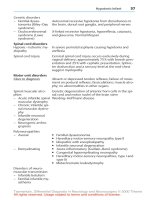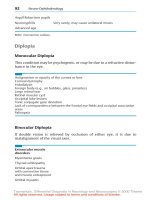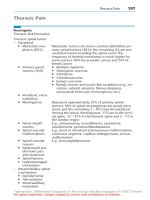Ebook Differential diagnosis in radiology (2e): Part 2
Bạn đang xem bản rút gọn của tài liệu. Xem và tải ngay bản đầy đủ của tài liệu tại đây (29.96 MB, 571 trang )
CHAPTER 6
Skeletal System
and Joints
6.1 ABNORMAL SKELETAL MATURATION
Skeletal Maturation Disorders
Retarded
1. Chronic ill health
– Congenital cardiac disorders.
– Chronic renal failure.
– Inflammatory bowel disease.
– Malnutrition including rickets.
– Maternal deprivation.
2. Chromosomal disorders
– Down’s syndrome.
– Turner’s syndrome.
– Trisomy 18, etc.
– Noonan syndrome.
– Prader-Willi syndrome.
3. Endocrinal disorders
–Hypothyroidism.
–Hypogonadism.
–Hypopituitarism.
– Cushing’s disease and steroid therapy.
4. Congenital syndromes
– Bone dysplasias.
– Malformation syndromes.
5. Miscellaneous
– Extreme emotional deprivation.
Skeletal System and Joints
Accelerated
a. Localized
1. Local hyperemia secondary to inflammation/infection.
2.Trauma.
3. Vascular malformations (hemangioma/AVM)
4. Klippel-Trenaunay-Weber syndrome.
5. Maffucci syndrome.
6.Neurofibromatosis.
7. Macrodystrophia lipomatosa (Fig. 6.1)
b. Generalized
i.Endocrinal
– Idiopathic sexual precocity
– Hypothalamic masses
– Adrenal and gonadal tumors
–Hyperthyroidism
Fig. 6.1: Anteroposterior radiograph of foot shows Macrodystrophia
lipomatosa involving 2nd and 3rd digits
385
386
Differential Diagnosis in Radiology
ii.Congenital
– McCune-Albright’s syndrome
– Cerebral gigantism
–Lipodystrophy
–Pseudohydrpoparathyroidism
– Weaver-Smith syndrome
– Marshall-Smith syndrome
iii.Miscellaneous
– Obesity in children.
Asymmetric
a. Localized Gigantism
Causes similar to localized accelerated maturation.
b. Localized Atrophy
1.Paralysis.
2. Radiation treatment in childhood.
Premature closure of growth plate
1.Localized hyperemia due to chronic inflammation as in
arthritides or infection, hemophilia.
2. Vascular malformation—AVM.
3.Trauma.
4. Radiation treatment during childhood.
5. Thermal injury—Burns and frostbite.
6. Multiple exostoses and enchondromatosis.
(Ollier’s disease)
6.2 SHORT LIMB SKELETAL DYSPLASIA
Rhizomelic
(Proximal Limb Shortening)
1. Achondroplasia
– Large skull with small base and sella and a small foramen
magnum.
Skeletal System and Joints
– Short ribs with deep concavities to anterior ends.
– Decreased interpedicular distance caudally in lumbar
spine.
– Short pedicles with narrow lumbar canal.
– Posterior scalloping with anterior vertebral body beaking.
– Square iliac wings with champagne glass pelvic cavity.
– Rhizomelic micromelic with bowing of long bones (Fig. 6.2).
– Trident hands.
2. Hypochondroplasia
– Similar to achondroplasia except skull never affected.
– Height normal or mildly reduced.
3. Pseudochondroplasia
– Similar to achondroplasia.
– Except that skull is normal.
– No changes seen in first year of life.
4. Chondrodysplasia punctata
– Stippling in long bone epiphysis, spine or larynx.
Fig. 6.2: Anteroposterior radiograph shows bowing of both
femurs with right relatively shorter than left
387
388
Differential Diagnosis in Radiology
Mesomelic
(Middle Segment Shortening)
1. Dyschondrosteosis
– Also known as Léri-Weill’s disease.
– Usually affects females.
– Madelung’s deformity.
– Medial aspect of proximal/distal tibia defective with or
without hypoplastic fibula.
2. Mesomelic dysplasia
– Type Langer.
– Type Reinhardt-Pfeiffer.
Acromesomelic
(Middle and Distal Segment Shortening)
1. Chondroectodermal dysplasia
– Also known as Ellis-van Creveld syndrome.
– Paired long bones are short with dome-shaped meta
physes.
– Abnormal medial tibial plateau with defective epiphyses
laterally.
– Postaxial polysyndactyly.
– Carpal fusions seen esp. capitate and hamate with delayed
development of carpal bones.
– Partial/total absence of teeth.
– Abnormal hair and nails.
– Rib cage similar to asphyxiating thoracic dystrophy.
2. Acromesomelic dysplasia
3. Mesomelic dysplasia
– Type Nievergelt.
– Type Robinow.
– Type Werner.
Skeletal System and Joints
Fig. 6.3: Anteroposterior radiograph of foot shows polydactyly
Acromelic
(Distal Segment Shortening)
1. Asphyxiating Thoracic Dystrophy
– Also known as Jeune’s disease.
– Thorax is stenotic.
– Ribs are short and horizontal and clavicles are highly placed.
– Polydactyly (Fig. 6.3).
2. Peripheral Dysostoses
6.3 SHORT SPINE SKELETAL DYSPLASIA
Disease
1.Pseudoachondroplasia
Spinal abnormality besides short spine
–Platyspondyly with exaggerated
apophyses.
–C1 and C2 dislocation.
grooves
for
ring
389
390
Differential Diagnosis in Radiology
Other features
– Short limbs.
– Marked joints laxity.
2. Spondylometaphyseal dysplasia
Like type Kozowski.
– Limb abnormalities besides spine involvement.
3. Spondyloepiphyseal dysplasia
a. Dominant variety.
–Congenita.
– Platyspondyly, maximal in thoracic spine.
Other features
– Severe tubular bone involvement.
– Retinal detachment common.
b.X-linked-tarda.
Spinal abnormality besides short spine
– Mounds of dense bone are found on superior and inferior
surfaces of the posterior part of vertebral endplates.
Other features
– Tubular bones minimally affected.
– Iliac wings are small.
– Hip degeneration frequently occurs prematurely.
c.Recessive.
Spinal abnormality besides short limbs
– Generalized platyspondyly of least severity.
Other features
Nil
4. Diastrophic dwarfism
Spinal abnormality besides other limb abnormalities
– Interpedicular narrowing in lumbar spine.
– Progressive kyphoscoliosis.
Other features
– Delta-shaped epiphyses.
– Hitchhiker thumb.
5. Metatrophic dwarfism
Spinal abnormality besides limb abnormalities
– Hypoplastic odoentoid.
– Severe progressive scoliosis.
Skeletal System and Joints
Other features
– Short limbs.
– Dumb-bell-shaped long bones.
6. Kniest syndrome
Spinal abnormality besides limb abnormalities
–Platyspondyly.
–Kyphoscoliosis.
– Interpedicular narrowing of lumbar spine.
Other features
– Dumb-bell-shaped long bones.
– Irregular epiphyses.
– Limited and painful joint movements.
6.4 LETHAL NEONATAL DYSPLASIA
1. Osteogenesis imperfecta
Type II
–Lethal in utero/early infancy.
– Sclerae are dark blue.
– Bones are grossly demineralized with thin cortices.
– Numerous healed or healing rib fractures.
Type II A – Long bones are short, broad and bowed.
– Ribs are broad with continuous beading.
Type II B – Long bones as in Type II A.
– Ribs show less or no beading.
Type II C – Long bones are thinned and show
multiple fractures.
– Ribs are too thin and beaded.
– Skull is enlarged with numerous wormian bones; Mineralization
may be retarded.
2. Thanatophoric dwarfism
– Infants are stillborn or die immediately after birth.
Rhizomelic dwarfism with bowing of long bones.
– Metaphyses are irregular.
– Epiphyses of knee absent.
– Short, wide, metacarpals and phalanges.
391
392
Differential Diagnosis in Radiology
3.
4.
5.
6.
7.
8.
9.
– Marked platyspondyly with ‘H-shaped’ vertebra on AP view
of spine.
– Poor mineralization of pelvic bones with small square iliac
blades.
– Clover leaf skull.
– Ribs are short and flared anteriorly.
Chondrodysplasia punctata
– Rhizomelic type (recessive) is lethal.
– Stippling or punctate calcification of tarsus and carpus,
long bone epiphyses, vertebral transverse processes and
pubic bones.
– Long bones show gross asymmetric shortening and
metaphyseal irregularity.
Asphyxiating thoracic dystrophy—Patients die in infancy from
respiratory distress.
– Thorax is stenotic.
– Ribs are short and horizontal.
– Clavicles are highly placed.
Campomelic dwarfism
– Long bones are bowed.
Achondrogenesis Type I and II
Short rib syndromes with or without polydactyly (Type I, II, III)
Homozygous achondroplasia
Hypophosphatasia—Gross general failure of ossification of
skeleton.
6.5 DUMB-BELL-SHAPED LONG BONES
1. Metatropic dwarfism—Short spine and short limb dwarfism.
2. Pseudochondroplasia—Short limb (Rhizomelic dwarfism).
3. Kniest syndrome—Short spine and short limb dwarfism.
4. Diastrophic dwarfism—Short spine and short limb dwarfism.
5. Osteogenesis imperfecta
Type III – Sclera blue at birth but usually normal in adolescence.
– Bones are demineralized.
– Vertebral compression and kyphoscoliosis.
Skeletal System and Joints
6.
– Long bone show multiple fracture and bowing.
– Sutures are wide with multiple wormian bones.
– Dentinogenesis imperfecta.
Chondroectodermal Dysplasia—Acromesomelic dwarfism with
ectodermal dysplasia.
6.6 MUCOPOLYSACCHARIDOSES AND
MUCOLIPIDOSIS (FIG. 6.4)
• They are characterized by constellation of radiological
signs related to skeletal system and share some common
characteristics as:
a. Abnormal bone texture
b. Widening of diaphyses.
c. Tilting of distal radius and ulna towards each other.
d. Pointing of proximal ends of metacarpals.
e. Large skull with calvarial thickening.
Fig. 6.4: Appendicular skeleton
393
394
Differential Diagnosis in Radiology
f. Anterior beaking of upper lumbar vertebrae.
g. J-shaped sella.
h. Flared ilia.
i. Fragmented femoral ossific nucleus.
6.7 MUCOLIPIDOSES
1. Type I (Neuraminidase deficiency)
2. Type II (I-cell disease)
3. Type III (Pseudopolydystrophy of Maroteaux)
6.8 GENERALIZED OSTEOSCLEROSIS
Children
i. Dysplasias
–Osteopetrosis.
–Pyknodysostosis.
– Craniotubular dysplasia.
– Craniotubular hyperostoses.
ii. Metabolic
– Renal osteodystrophy.
iii. Poisoning
– Lead = Dense metaphyseal bands.
– Flask-shaped femora.
– Fluorosis = Thickened cortex with narrow medulla.
– Ossification of tendons, ligaments and interosseous
membranes.
– Hyper- = Dense metaphyseal bands.
vitaminosis D = Widened zone of provisional calcification.
– Soft tissue calcification.
– Hyper- = Subperiosteal new bone
vitaminosis A formation.
– Reduced metaphyseal density.
Skeletal System and Joints
iv.Idiopathic
– Caffey’s disease.
– Idiopathic hypercalcemia of infancy.
Adults
i. Myeloproliferative
–Myelosclerosis.
– Marrow cavity narrowed by endosteal reaction.
– Patchy lucencies due to fibrous tissue.
ii. Metabolic
– Renal osteodystrophy.
iii. Poisoning
–Fluorosis.
– Similar as in children.
iv. Neoplastic
– Osteoblastic metastases (Figs 6.5A and B).
A
B
Figs 6.5A and B: Anteroposterior and lateral radiographs of LS spine
show osteoblastic metastases
395
396
Differential Diagnosis in Radiology
Fig. 6.6: Paget’s disease: Early long-bone changes. Lateral view of the
humerus in a middle-aged man shows an “advancing wedge” (“blade of
grass” or “flame shadow”) appearance at the end of the bone, characteristic of early Paget’s disease. Since the disease process generally proceeds
from one articular end of the long bone to the other, all three phases—
early, intermediate and late—may be seen in the same bone
–Lymphoma.
–Mastocytosis.
– Sclerosis of marrow with patchy areas of lucency.
v. Idiopathic
– Paget’s disease (Figs 6.6 to 6.8).
– Coarsened trabeculae.
– Bone expansion.
6.9 SCLEROTIC BONE LESIONS
Developmental
i.Single
a.Fibrous dysplasia.
b.Bone islands (Enostosis)
Skeletal System and Joints
Fig. 6.7: Paget’s disease: Late long-bone changes. Lateral view of the
tibia shows anterior bowing secondary to late-phase
– Round/Oval dense lesion in medullary location with
radiating thorn-like spicules.
– Usually <15 mm.
– Grow up to skeletal maturity.
ii.Multiple
a.Bone islands.
b.Fibrous dysplasia.
–Cyst-like lesion in diaphysis or metaphysis with
endosteal scalloping +/– bone expansion with thick
sclerotic border (rind sign)
– Age = 3 to 15 years.
c.Osteopoikilosis/Osteopathia condensans disseminata
– Dense round/oval/Lanceolate lesion arranged parallel
to long-axis of bone.
397
398
Differential Diagnosis in Radiology
1. Osteoporosis circumscripta
2. Basilar invagination
3. Advancing wedge
Fig. 6.8: Progression of Paget’s disease: a, c and e early (osteolytic) “hot”
phase and b, d and f late (osteoblastic) “cold” phase manifestations of
Paget’s disease in (a, b) the skull, (c, d) vertebrae, and (e, f) long bones,
a. Osteoporosis circumscripta, b. “Cotton-wool” appearance. c. Biconcave
vertebra. d. “Picture frame” ivory vertebra. e. “Flame,” “blade of grass”
deformities. f. Dense, larger diameter deformities
Skeletal System and Joints
Fig. 6.9: Osteoid osteoma. The frontal projection shows an enlarged,
dense right pedicle (3) and pars interarticularis (5), characteristic of osteoid osteoma (compare with normal pedicle on left (4 & 6).
Fig. 6.10: Osteoid osteoma
399
400
Differential Diagnosis in Radiology
– Seen usually at ends of long bones and around joints; in
the carpus and tarsus.
– No interval change.
d.Osteopathia striata/voorhoeve’s disease
Sclerotic striations in long bones parallel to long-axis
affecting both diaphysis and metaphyses.
e.Tuberous sclerosis
– Patchy, sclerotic lesions in skull, vertebrae, pelvis and long
bones with irregular periosteal new bone formation.
Vascular
• Bone infarcts
(Single/Multiple).
• In sickle cell anemia.
– Sclerotic lesions in femoral or humeral head in medullary
bone.
– Sharply-defined or ill-defined diffuse sclerosis.
Traumatic
• Callus (Single/multiple fracture sites)
Infective
• Sclerosing osteomyelitis of Garré.
– Localized gross sclerosis in absence of apparent bone
destruction.
Idiopathic
• Paget’s disease.
(Single/Multiple).
– Coarsened trabeculae, cortical thickening and bone
expansion.
– Encroachment of medullary cavity with epiphyseal
involvement as well.
– “Cotton-Wool spots” in skull.
Skeletal System and Joints
Neoplastic
i.Single
a.Metastases.
b. Lymphoma. (De novo or after RT of a lytic lesion)
c.Osteoma.
– Usually skull, PNS and mandible.
d. Ivory or dense type; spongy or trabeculated type.
Broad-based with smooth well-defined margins.
e.Osteoid osteoma (Figs 6.9 and 6.10)
– Round/oval radiolucent lesion with dense surrounding
sclerosis with a central nidus <1 cm.
– Lesion sited in relation to cortical bone with dense
scleroses extending into medullary cavity as well.
f.Osteoblastoma
– Similar to osteoid osteoma but central radiolucency is
larger, approx. 2–10 cm in diameter.
g.Primary bone sarcoma
– Commonest being osteosarcoma.
– Wide zone of transition with periosteal reaction and
soft tissue extension.
– Healed/Healing benign or malignant bone lesions as
lytic areas following RT on CT, bone cyst, fibrous cortical
defect, etc.
A
B
Figs 6.11A and B: (A) Nonossifying fibroma; (B) Osteoblastoma
401
402
Differential Diagnosis in Radiology
ii. Multiple
–Metastases.
–Lymphoma.
–Osteomas.
(Gardner’s syndrome).
– Osteomas, soft-tissue tumors, polyposis coli).
a. Mastocytosis
– Circumscribed areas of increased density due to thickening
of medullary trabeculae (Figs 6.11A and B).
– Coarsened appearance of bone with indistinct endosteum.
b. Multifocal osteosarcomas
– Multiple myeloma.
– in 2 to 3%.
c. Multiple healed/healing benign or malignant bone lesions.
6.10 BONE SCLEROSIS ASSOCIATED
WITH PERIOSTEAL REACTION
Traumatic
• Healing fractures with callus formation.
Neoplastic
•
•
•
•
•
•
Metastases.
Lymphoma.
Osteoid osteoma/osteoblastoma.
Osteosarcoma.
Ewing’s sarcoma (Fig. 6.12).
Chondrosarcoma.
Infective
• Osteomyelitis.
• Syphilis.
Skeletal System and Joints
Idiopathic
i. Infantile cortical hyperostoses (Caffey’s disease)
– Age of onset is nine weeks.
– Marked periosteal proliferation and cortical thicken
ing
beneath soft tissue swellings.
– Bones affected are mandible, ribs, scapula, ulna and any
other bone except phalanges and spine.
– In long bones, diaphysis is only involved.
ii. Melorheostosis/Leri’s disease
– Dense irregular bone running along cortex of long bone,
both externally and internally.
(Dripping candle wax appearance).
– Lower limbs are commonly involved.
– Lesions are segmental and unilateral in distribution.
6.11 SOLITARY SCLEROTIC
LESION WITH LUCENT CENTER
Neoplastic
i.
ii.
Osteoid osteoma
– Central lucent center <1 cm.
Osteoblastoma
– Central lucency
– 2–10 cm in diameter.
Infective
i.
ii.
Brodie’s abscess
– Metaphyseal lytic lesion with surrounding sclerosis.
– Tunnelling toward epiphyseal plate is pathognomonic.
Granulomatous
(Syphilis, Tuberculosis).
403
404
Differential Diagnosis in Radiology
6.12 COARSE TRABECULAR PATTERN OF BONE
1. Paget’s disease
– Expansion of bone is associated.
2.Osteoporosis.
3.Osteomalacia.
4.Hemoglobinopathies
– Especially thalassemia
– Expansion of marrow cavity destroys medullary trabeculae.
5.Hemangioma
– Of vertebral bodies produces vertical coarse trabecular
pattern with slight expansion (caudry cloth appearance).
6. Renal osteodystrophy
– Associated sclerosis and subperiosteal bone formation is
evident.
7.Osteonecrosis
– Cystic defects with coarse trabecular pattern; periostitis
and increased bone density may be seen if infection is the
causative factor.
8. Fibrogenesis imperfecta ossium
– Obliteration of trabecular architecture with coarsening of
remaining trabeculae.
9. Gaucher’s disease
– Associated with hypoplasia of vertebral bodies, thinning
of cortices of tubular bones and subperiosteal new bone
formation.
10. Neoplasms as chondromyxoid fibroma where new bone is
laid in pattern of coarse trabeculae.
Skeletal System and Joints
6.13 RELATIONSHIP OF METASTATIC
LESIONS TO THE PRIMARY TUMORS
Location of primary tumor/variety of
primary tumor
Lytic
1.
Bronchogenic carcinoma
2.
Bronchogenic carcinoid
3.
Breast
4.
Gastric carcinoma
5.
Colon
6.
Rectum
7.
Renal cell carcinoma
8.
Wilms’ tumor
9.
Bladder
10.
Prostate
11.
Thyroid
12.
Pheochromocytoma
13.
Adrenal carcinoma
14.
Neuroblastoma
15.
Cervix
16.
Uterus
17.
Ovary
18.
Testes
19.
Squamous cell
carcinoma of skin
20.
Melanoma
Characteristic of metastatic
lesions
Blastic
Mixed
(occasionally)
(rarely)
(rarely)
Expansile
405
406
Differential Diagnosis in Radiology
Fig. 6.12: Ewing’s sarcoma. A permeative destructive lesion can be observed in the diaphysis of the distal ulna. Fracture callus merges with a
“sunburst” periosteal reaction. The cortex on the radial aspect of the ulna
is destroyed by a soft-tissue mass growing out into the soft tissue. A short,
oblique pathologic fracture is also evident. Ewing’s sarcoma cannot be
differentiated radiologically from a nonHodgkin’s lymphoma. The latter occurs in an older age group (third and fourth decades). Differentiation from
osteomyelitis can be difficult. However, unlike Ewing’s sarcoma, metaphyseal involvement is usually a prominent feature of childhood osteomyelitis
(See labelling on the next page in Figure 6.13)
6.14 CHILDHOOD TUMORS
METASTASIZING TO BONE (TABLE 6.13)
1.Neuroblastoma.
2. Leukemias and lymphoma.
3. Clear cell sarcoma
(Variant of Wilms’ tumor).
4.Rhabdomyosarcoma.
Skeletal System and Joints
1. Destructive lesion
2. Soft-tissue mass
3. Pathologic fracture
4. Periosteal reaction
5. Saucerization
6. Well-organized periosteal reaction
Fig. 6.13: Ewing’s tumor
5.Retinoblastoma.
6. Ewing’s sarcoma (Figs 6.12 and 6.13).
7.Osteosarcoma.
6.15 BUBBLY BONE LESIONS
Neoplastic
Benign
1.GCT.
2.Angiomas.
3. Chondromyxoid fibroma (Figs 6.15 and 6.16).
4. Enchondroma (Fig. 6.14).
407
408
Differential Diagnosis in Radiology
Malignant
1.GCT.
2.Osteoblastoma.
3. Multiple myeloma.
4. Metastases (Kidney and thyroid).
Infection
1. Brodie’s abscess.
2.Coccidioidomycosis.
3.Echinococcus.
Endocrinal
Fig. 6.14: Enchondroma
1.Hyperparathyroidism.
Fig. 6.15: Chondroblastoma
Fig. 6.16: Chondromyxoid fibroma









